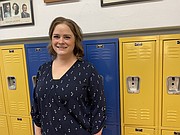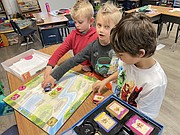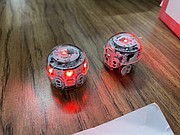Grants help everyone at Wilson Creek schools be educators
WILSON CREEK — There aren’t a lot of school districts in Washington state where $15,000 will go very far, but Wilson Creek happens to be one of them.
“We got two grants for this year,” said Anna Thomas, dean of students at the Wilson Creek School. “Both of them went to support STEM and computer science technologies at the elementary school.”
In a district with 109 full-time students and better known for its agriculture-centered vocational education program, the grants bought a box of Ozobots, little round robots you can command by drawing lines of certain lengths and colors for them to follow; tablet computers; some games that will help kindergartners begin to learn how to think about programming computers;, and a room full of 3-D printers that students are slowly teaching themselves — and their teachers — how to use.
The goal at Wilson Creek, which has a budget of $3.7 million for the 2021-22 school year, according to Thomas, is to start having kids in this very rural corner of Grant County learn the skills for tomorrow’s jobs.
Because even farm machinery these days is networked, connected, high-tech and programmable.
“It’s one more benefit we can give our kids,” said Warden Creek Superintendent Laura Christian. “I think, especially with our size, anyone that wants to involve themselves in the program can.”
In bigger schools and school districts, Christian said it’s often first-come, first-serve - or get on a waiting list and wait for a slot to open.
“But we have the benefit of knowing each kid so we know if they’re ready, if they’ve got the skills leading into it before they even try to sign up,” she said.
STEM — science, technology, engineering and mathematics — education starts in Wilson Creek even before anyone gets a computer or a robot in their hands, Thomas said. The district’s kindergartners — all nine of them — start by playing a board game called Robot Turtles in which kids put together a series of card instructions — go forward, turn left, turn right, knock down walls — to get a turtle through a maze in order to get a jewel.
“It’s a real basic game that can be played as early as preschool,” said Veronica Clinton, who teaches third and fourth grades. “But it still has the very basics of coding and directions and getting your turtles where you want them to go.”
From there, Clinton said, her students also play with Squishy Circuits — Play-Doh-like clay that either conducts or resists electricity — and the golf-ball sized Ozobots, which can follow lines and do tasks based on the color or pattern in the lines they follow.
“They made a car with headlights that actually turned on, or lights down the back of a dinosaur,” Clinton said of the students’ squishy circuit creations.
Fourth-graders Maxx Herreid and Liam Ulman draw long lines with a fat, black felt-tip marker on a piece of clean paper, set the Ozobot down, and watch it follow the line. Different colors, and different combinations of colors, give the Ozobot instructions to slow down, speed up, turn around, flash its lights or other options.
“Here is one that can get it to do a victory dance,” Liam said and he puts down a colored marker and places the robot on the line.
Upstairs, in what used to be the Wilson Creek School library, a small group of teenagers fiddles with a half-printed plastic pumpkin and a 3-D printer. The bottom two-thirds of the pumpkin was printed when the spool of plastic filament ran out, and they want to both replace the filament and finish printing their red plastic pumpkin.
“We’re trying to cut off the top (of the computer model),” said freshman Josie McMillan as she sat intently in front of a computer screen.
It’s a somewhat perplexing task, she said, since she and sophomore Erin Johnson are trying to delete a portion of the computer model that will allow them to complete the partially-printed pumpkin and match it with what they have.
“It already has some of the eyes, so we need (to cut) a little more but I gotta figure out how to do that,” McMillan said.
For Thomas, who was a STEM education specialist in the Spokane schools before coming to Wilson Creek, the fact that students are struggling to figure out technology no one in the district really knows how to use is one of the benefits of the program.
“Often, in schools, we don’t give kids the chance to really problem-solve, to strategize and solve puzzles and things like that,” she said. “And that’s what they’re doing by themselves. It’s incredible, and that’s what we’ve been seeing.”
The goal is for the older kids, once they’ve figured out how these things work, to show everyone else, Thomas said. It’s one way Wilson Creek shows that there are some advantages to being a very small school district.
“Kids don’t fall through the cracks here. They have relationships with everyone in our school, and it’s not just the teachers,” she said. “Everybody gets to be an educator here. All of the students, they get individualized attention and individualized relationships.”
That environment is somewhat unique in education, she added.
“I’ve never seen that in another building,” Thomas said.
Charles H. Featherstone can be reached at cfeatherstone@columbiabasinherald.com.









